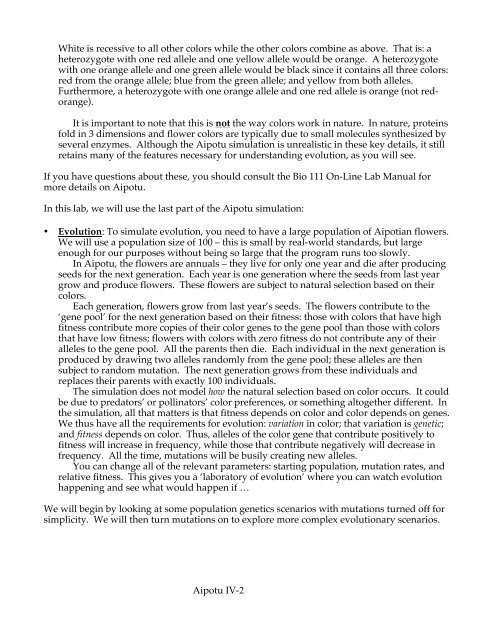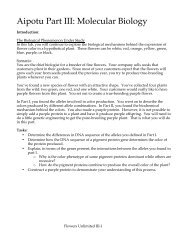Evolution Lab Manual in .pdf format - Aipotu
Evolution Lab Manual in .pdf format - Aipotu
Evolution Lab Manual in .pdf format - Aipotu
Create successful ePaper yourself
Turn your PDF publications into a flip-book with our unique Google optimized e-Paper software.
White is recessive to all other colors while the other colors comb<strong>in</strong>e as above. That is: aheterozygote with one red allele and one yellow allele would be orange. A heterozygotewith one orange allele and one green allele would be black s<strong>in</strong>ce it conta<strong>in</strong>s all three colors:red from the orange allele; blue from the green allele; and yellow from both alleles.Furthermore, a heterozygote with one orange allele and one red allele is orange (not redorange).It is important to note that this is not the way colors work <strong>in</strong> nature. In nature, prote<strong>in</strong>sfold <strong>in</strong> 3 dimensions and flower colors are typically due to small molecules synthesized byseveral enzymes. Although the <strong>Aipotu</strong> simulation is unrealistic <strong>in</strong> these key details, it stillreta<strong>in</strong>s many of the features necessary for understand<strong>in</strong>g evolution, as you will see.If you have questions about these, you should consult the Bio 111 On-L<strong>in</strong>e <strong>Lab</strong> <strong>Manual</strong> formore details on <strong>Aipotu</strong>.In this lab, we will use the last part of the <strong>Aipotu</strong> simulation:• <strong>Evolution</strong>: To simulate evolution, you need to have a large population of Aipotian flowers.We will use a population size of 100 – this is small by real-world standards, but largeenough for our purposes without be<strong>in</strong>g so large that the program runs too slowly.In <strong>Aipotu</strong>, the flowers are annuals – they live for only one year and die after produc<strong>in</strong>gseeds for the next generation. Each year is one generation where the seeds from last yeargrow and produce flowers. These flowers are subject to natural selection based on theircolors.Each generation, flowers grow from last year’s seeds. The flowers contribute to the‘gene pool’ for the next generation based on their fitness: those with colors that have highfitness contribute more copies of their color genes to the gene pool than those with colorsthat have low fitness; flowers with colors with zero fitness do not contribute any of theiralleles to the gene pool. All the parents then die. Each <strong>in</strong>dividual <strong>in</strong> the next generation isproduced by draw<strong>in</strong>g two alleles randomly from the gene pool; these alleles are thensubject to random mutation. The next generation grows from these <strong>in</strong>dividuals andreplaces their parents with exactly 100 <strong>in</strong>dividuals.The simulation does not model how the natural selection based on color occurs. It couldbe due to predators’ or poll<strong>in</strong>ators’ color preferences, or someth<strong>in</strong>g altogether different. Inthe simulation, all that matters is that fitness depends on color and color depends on genes.We thus have all the requirements for evolution: variation <strong>in</strong> color; that variation is genetic;and fitness depends on color. Thus, alleles of the color gene that contribute positively tofitness will <strong>in</strong>crease <strong>in</strong> frequency, while those that contribute negatively will decrease <strong>in</strong>frequency. All the time, mutations will be busily creat<strong>in</strong>g new alleles.You can change all of the relevant parameters: start<strong>in</strong>g population, mutation rates, andrelative fitness. This gives you a ‘laboratory of evolution’ where you can watch evolutionhappen<strong>in</strong>g and see what would happen if …We will beg<strong>in</strong> by look<strong>in</strong>g at some population genetics scenarios with mutations turned off forsimplicity. We will then turn mutations on to explore more complex evolutionary scenarios.<strong>Aipotu</strong> IV-2



